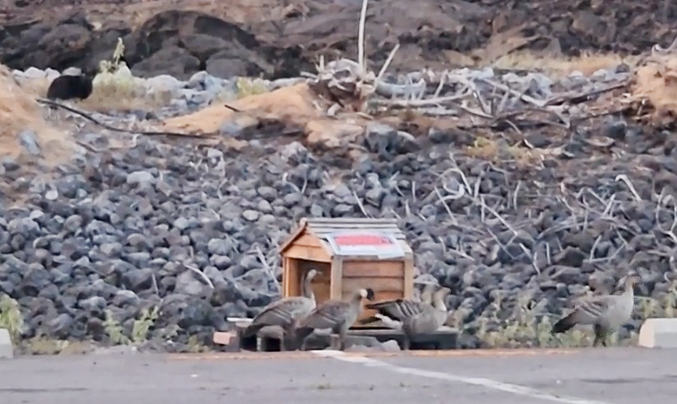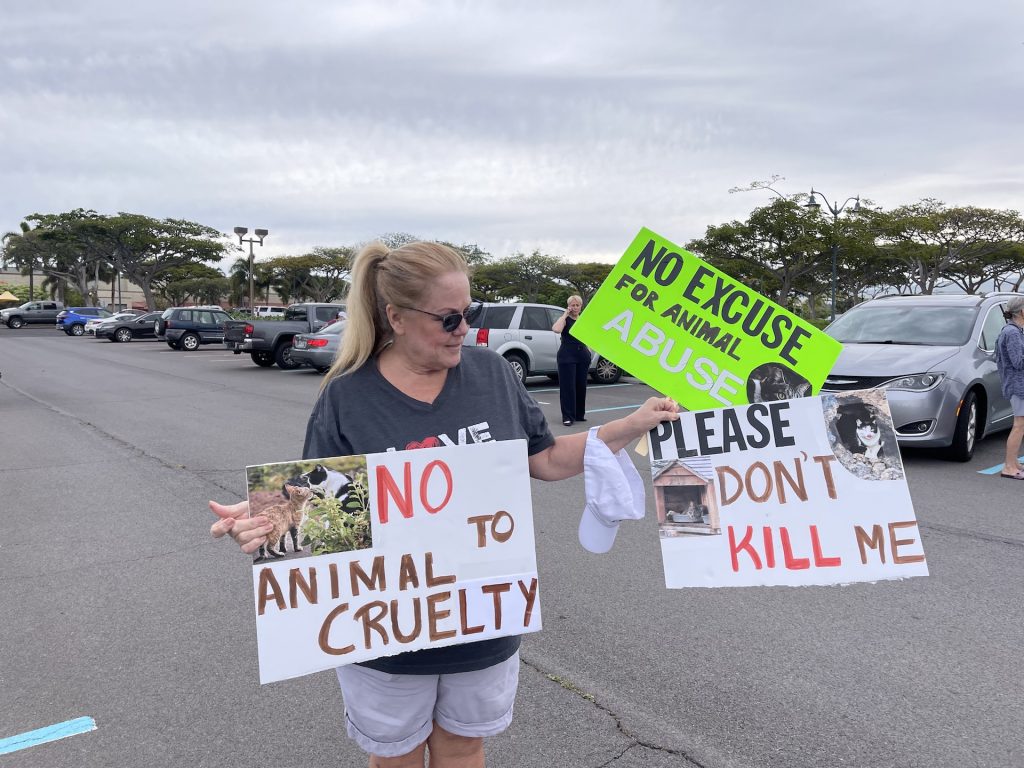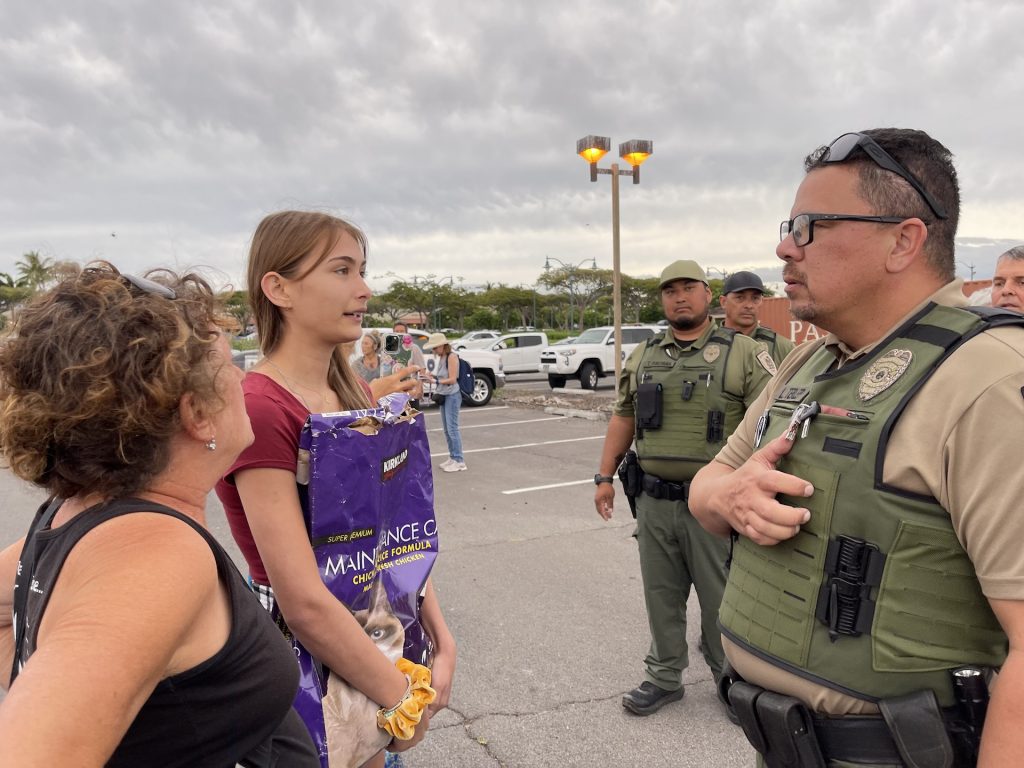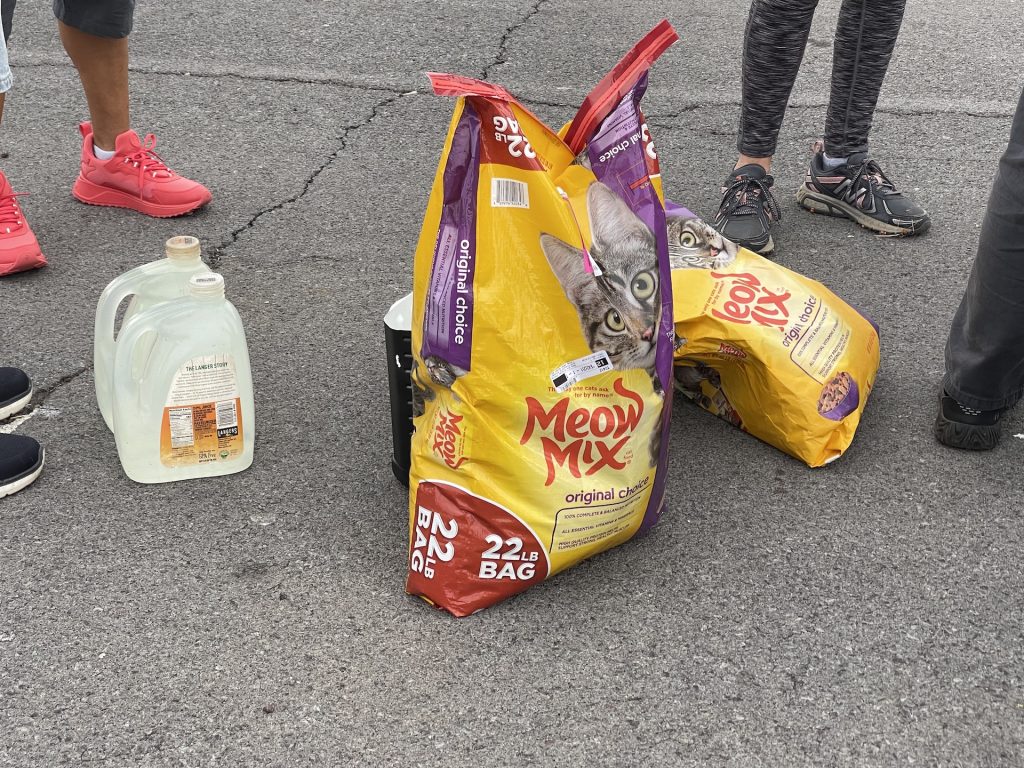Protest at Big Island shopping center over state ordered removal of cat feeding stations

Several cats and one nēnē watched together from a distance on Tuesday night as a large group of people gathered in the back parking lot at Queens’ Marketplace in Waikōloa to protest the removal of the longtime feline feeding and watering stations.
Six days earlier, the Hawaiʻi State Department of Land and Natural Resources ordered real estate company Alexander & Baldwin, owner of the Big Island shopping center, to remove the stations.
The mandate came after the state confirmed a complaint that nēnē (Hawaiian goose) were “observed consuming the cat food and regularly spending time among the feral cat colony, which has resulted in harm to nēnē.”
Nēnē are endangered and also the Hawaiʻi state bird, so protecting them is a priority of the state.
But protecting the “community” cats of Waikōloa was the priority of at least 50 people, young and old, who gathered at the shopping center, chanting: “Stop starving the cats.”
Also at the parking lot were at least nine state conservation enforcement officers and six Hawai’i Island police officers, all of them armed.
Dan Dennison, spokesperson for the Department of Land and Natural Resources, said the large officer presence was for safety and crowd control after seeing several social media postings calling for people to protest.
They also were there for enforcement.

One woman placed a bowl of water down in the lava field next to the parking lot. A state conservation officer dumped the bowl.
Sixteen-year-old Averie Sasaki walked along the edge of the lava field carrying a bowl full of cat food, saying: “I think it’s cruel and I don’t want animals to suffer.”
She called for the felines to come to her in hopes of feeding them, knowing it would result in a fine. She said: “I’m willing to take a fine because it’s right. Who’s to say one species is better than the other. It’s unfair to say that nēnē are more important than cats. They’re all God’s creations.”

The teenager ultimately wasn’t fined.
But two women from Waikōloa were cited by state conservation and resources officers for “prohibited take of endangered species” by putting bowls of cat food on the ground. Both women also were told by a Queensʻ Marketplace security officer that they were trespassing and were no longer allowed anywhere on the property, according to a state press release.

A third woman was issued a warning after being spotted pouring cat food into bowls behind a shed.
The fines that the two women received are not cheap, at $2,500 each.
Debbie Cravatta, founder of Kohala Animal Relocation and Education Service, adamantly told conservation officers not being allowed to feed the cats is archaic. She also collected cash from the crowd to help pay for the womenʻs citations. She also said she would start a Go Fund Me page.
Many of the protesters are volunteers from various cat rescue organizations, along with the nonprofit ABaykitties, an organization that has been feeding the community cats for 20 years and has worked with Catsnip to get the cats spayed and neutered.
Among the community cats is 6-year-old black and white Mini Me, also known as M & M, who isnʻt easily adoptable because of her age and because she is afraid of people.
“He’s destined to live in the parking lot and die of starvation,” said Dawn Garlinghouse, a volunteer of ABaykitties since 2016 and now its director. “We’re trying to get the word out that this is inhumane and that they shouldn’t be allowed to let these animals suffer.”
Garlinghouse said the “community” cats at Queens’ Marketplace are not feral: “They’re spayed, neutered and cared for. They come for medical attention, and those that we can adopt are re-homed.”
Garlinghouse said her organization does adoptions through Petco and Catsnip Hawaiʻi in Kapa‘au: “We get as many as we can into homes. They’re only returned to the property if there isn’t a foster available or they’re not adoptable.”
The organization has been working with Queens’ Marketplace for years in this feeding and trap-neuter-release program in an effort to reduce the cat population and keep them from roaming the shopping center.
Garlinghouse said ABay Kitties has always had a great relationship with Alex & Baldwin. But it was not through the company, but a social media post on April 2, that she found out about the one complaint regarding the nēnē eating cat food at the Waikōloa property.
After learning about the complaint, she said the volunteers at ABay Kitties changed the feeding times from 4 p.m. to after-hours. She also volunteered to build nēnē-proof feeding stations, however, the Department of Land and Natural Resources didn’t take her up on the offer.
Garlinghouse said volunteers feeding the cats are not intentionally feeding the nēnē.
While the indigenous goose is found at a variety of elevations and habitats, Garlinghouse said in the years she’s been feeding the cats, she hasn’t known the birds to be permanent residents of the area by the shopping center, describing it as a baron lava field.
Feral cats, as well as dogs and mongoose, are considered predators to the nēnē. The endangered birds also have been killed by being run over by vehicles.
The nēnē, who like the manicured greenery of golf courses, also have suffered injury or death by errant golf balls or accidental collisions with golf carts on the Big Island. Linda Elliott, president of the Hawaiʻi Wildlife Center Linda Elliott, told Spectrum News in September 2022 that 40 nēnē had been injured on golf courses in the state in the first nine months of that year.
Garlinghouse said she’s an “animal person” and doesn’t want to harm the nēnē, but questions why the cats are being singled out and thinks it might be about furthering an agenda to get rid of free-roaming cats.
In 2022, the Hawaiʻi State Legislature was considering House Bill 1987 that had a goal of eliminating the feral cat populations on the Big Island, Kauaʻi and Maui, and reducing Oʻahuʻs population by 50%, by the end of 2024. But after overwhelming opposition to eradication that including poison bait methods, the bill was deferred.
Kanalu Sproat, a biologist with the state Division of Forestry and Wildlife, said nēnē historically nest in the wetlands and marshes. He is unaware of searches done in the area behind Queens’ Marketplace for nēnē nests.
He said the endangered birds are getting habituated to the area. One day earlier, the state Department of Land and Natural Resources shot video that showed several nēnē around the feeding station.
But at this time, Sproat said the state has no plans to address this problem, other than to stop the feeding at this one location.
Kayla Tano, who was at the parking lot with her 4-year-old son, said: “Starving cats is not an answer. There has to be a better solution.”
The state officials said they, too, do not want the cats to starve to death.
Sproat said he knows there is not an easy solution because there are free-roaming cats everywhere that are being fed.
Alexander & Baldwin was given until April 25 to remove the cat-feeding stations.
“If Alexander & Baldwin does not comply with the Department of Land and Natural Resources directive to remove the cat-feeding stations from its property, and prohibit further feeding, it could face penalties for illegal take of a protected species,” said a letter sent to Alexander & Baldwin by Dawn Chang, chair of the Department of Land and Natural Resources.
But in a statement, Alexander & Baldwin said it intends to meet the deadline: “We’ve notified the organization that feeds the feral cats in the Waikōloa Beach Resort community to remove the stations they maintain. If the stations are not removed, the Company will remove them to ensure A&B does not violate the law or risk penalties under Hawai‘i Revised Statutes (HRS) Chapter 195D.”
The Department of Land and Natural Resources also has suggested that action be taken to capture feral cats and remove them from the landscape because they pose a threat to nēnē and other native wildlife through direct predation and spreading toxoplasmosis, a parasite found in cat feces.

This disease is one of the main threats and leading causes of death facing the endangered Hawaiian monk seal population in the main Hawaiian Islands.
“While we recognize that some members of the community feel a strong attachment to feral cats, DLNR’s mission and mandate is to protect and preserve these endangered and endemic species,” Chang’s letter said. “… We hope the people of Hawaiʻi will help by keeping all cats inside, adopting if they can provide safe indoor homes, and not putting food outside that our native wildlife might eat.”
But the Department of Land and Natural Resources did not say what should be done with the cats who now hang out at the shopping center, or how simply not feeding them solves the problem.
Dennison said the state can’t mandate what is done with the cats because cats are not in its jurisdiction.
The jurisdiction for free-roaming cats is the county and its new Animal Control and Protection Agency.
The Hawaiʻi Island Humane Society, in a Facebook post, weighed in, saying the solution to the problem was not simply removing the feeding stations.
The post said: “The topic of community or ‘free-roaming’ cats can be a multi-faceted concern that draws opinions from many interest groups, including cat caretakers, public health officials, wildlife agencies, environmental conservationists and more. There can be solutions that prioritize the protection of our native and endemic wildlife while also promoting the humane and effective reduction of the population of free-roaming/community cats.”
The humane society, which does not manage the colony, said it is not a realistic solution to relocate community cats to a shelter or rescue group because there is not the capacity to do so. It also said implementing a feeding ban and humane euthanasia aren’t effective solutions either.
According to the Humane Society of the United States: “When cats are removed, unmanaged cats from surrounding areas may move in to take advantage of the newly available resources. The cycle of reproduction and ‘nuisance behavior’ begins all over again.”
Feeding bans, including the removal of feeding stations, also are illogical because it will not force cats to go away, but rather make them more difficult to manage.
John Niski of Waikōloa, who came to support his friends with two bags of food and three jugs of water, said once the cats stop getting fed, they will go into the resort and get into trash and kill other animals.
The humane society agrees: “It will also force cats to forage through the trash and become a greater threat to wildlife,” the Facebook post stated. “Feeding stations are essential to the effective and humane management of free-roaming cats.”
Sponsored Content
Comments


















